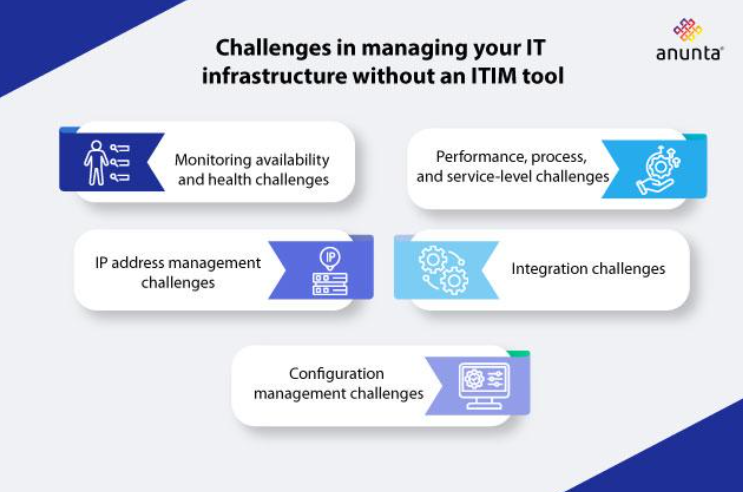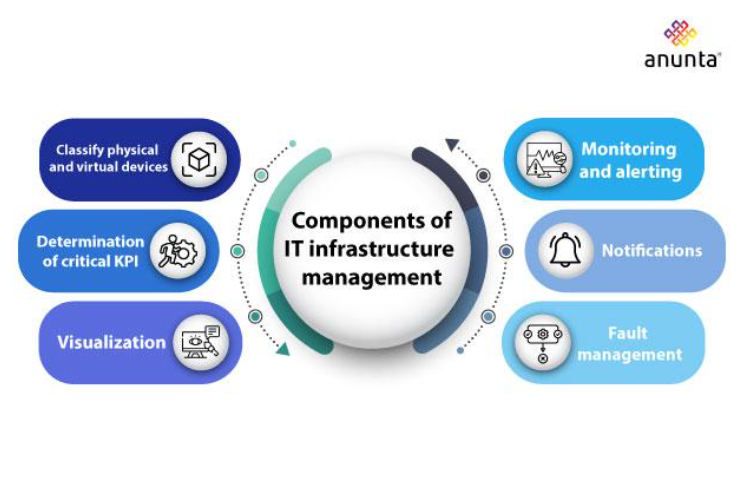
Having robust IT infrastructure services is critical for any business. From managing networks to storing data, these services keep everything running smoothly. But what exactly are IT infrastructure services, and why are they so important? Join us as we explore the essentials and discover how these services can boost your business’s success. Ready to learn how top-notch IT support can set you apart in a tech-driven world? Keep reading!
Infrastructure management involves overseeing and maintaining essential IT infrastructure to optimize resource usage, safeguard data, and monitor local and cloud-based services. IT infrastructure services ensure complex IT systems operate effectively to support business operations, often using a hybrid model that integrates local and cloud assets.
Infrastructure management provides structure and visibility for IT assets. Maintaining complex infrastructure may lead to redundant services and increased operational efforts without a comprehensive view of all systems across different locations. The simplest way to understand infrastructure management is to break it down into three main categories:
Managing IT infrastructure without an ITIM (IT Infrastructure Management) tool can lead to several difficulties. Here’s a breakdown of the main issues you might face:

IT infrastructure management starts by ensuring the constant availability and health of all network-connected devices and interfaces. To prevent unexpected disruptions, critical devices require 24×7 monitoring.
Efficient monitoring of IT infrastructure performance demands a systematic approach. Managing vendor diversity is crucial to identifying key performance metrics such as CPU usage, memory utilization, packet drop rates, temperature, and fan speed for optimal efficiency. Prioritizing specific devices and their parameters depends on monitoring criticality and device importance.
The effectiveness of IT infrastructure in delivering business solutions hinges not only on device availability but also on the continuity of services and processes. Any interruption in IT infrastructure management services or processes can directly impact intended business solutions, potentially resulting in business losses.
When integrating new devices into your IT infrastructure, avoiding IP address conflicts is crucial by ensuring no two devices share the same IP. Keep a close watch on IP addresses to efficiently assign available ones and block any devices with rogue IPs to protect your network’s security.
Compelling IT infrastructure management solutions go beyond device monitoring and timely alert reception. It necessitates promptly addressing identified faults, wherein integrations are pivotal. These integrations extend the functionality and monitoring capabilities of IT infrastructure management tools. Opting for a tool that integrates seamlessly with essential third-party systems like ITSM, communication, and alarm management tools significantly enhances network operational efficiency.
Configuration changes in your infrastructure should be approved based on roles. Every configuration change carries the risk of errors that could lead to downtime. Factors like misconfigurations, incorrect parameter changes, and conflicting values can all contribute to these issues.
Human errors during critical processes, such as firmware upgrades, can disrupt the entire network. Ensure you have a backup disaster recovery plan as a safety net and keep a detailed record of all configuration changes made to infrastructure devices.
Market Overview
IT infrastructure management is a broad field that encompasses various components to ensure that an organization’s IT environment is efficient, reliable, and secure. Here are the main components:

Classify physical devices (servers, routers) and virtual environments to detect performance issues, errors, and malfunctions. This approach ensures optimal performance and efficient management of all devices.
Classify devices based on their criticality and define essential KPIs for each. Effective IT infrastructure management requires focusing on these critical metrics to address issues and optimize performance.
Comprehensive visibility into IT infrastructure allows technicians to track performance and metrics. This proactive approach helps prevent device failures and reduces downtime.
Continuous monitoring combined with proactive alerts ensures timely detection of network faults. This process is crucial for maintaining network stability and preventing malfunctions.
Send accurate notifications through appropriate channels to the right technician team. This practice helps swiftly address issues and build a resilient network.
Automate essential L1 and L2 network operations to quickly resolve faults. This strategy improves device performance and significantly reduces Mean Time to Repair (MTTR).
Anunta is a top-tier solution for IT organizations to streamline infrastructure management. They allow you to aggregate log data from applications and machines, visualize it through real-time dashboards, and leverage insights for better infrastructure decisions.
With Anunta, you can assess network activity for optimal resource allocation, uncover user behavior trends for strategic operations, and receive real-time feedback on the health of both virtual and physical assets, transforming how you manage your IT infrastructure.
Q: What is IT infrastructure management?
A: IT infrastructure management involves overseeing and maintaining hardware, software, networks, and services to ensure they operate effectively and support business operations. It includes managing storage, systems, and networks to optimize resource use, safeguard data, and ensure continuity of services.
Q: What are the main components of IT infrastructure management?
A: The main components are:
Q: What challenges might arise without an ITIM tool?
A: Without an ITIM (IT Infrastructure Management) tool, you might face challenges such as:
Q: How does Anunta improve IT infrastructure management?
A: Anunta enhances IT infrastructure management by aggregating log data, providing real-time dashboards, and offering insights for better decision-making. It helps assess network activity, uncover trends, and get real-time feedback on infrastructure health.
Q: Why are IT infrastructure services important for businesses?
A: IT infrastructure services are crucial for businesses because they ensure the smooth functioning of IT systems, which are essential for daily operations. These services help manage networks, store data, and maintain system performance, which is critical for business efficiency and continuity.